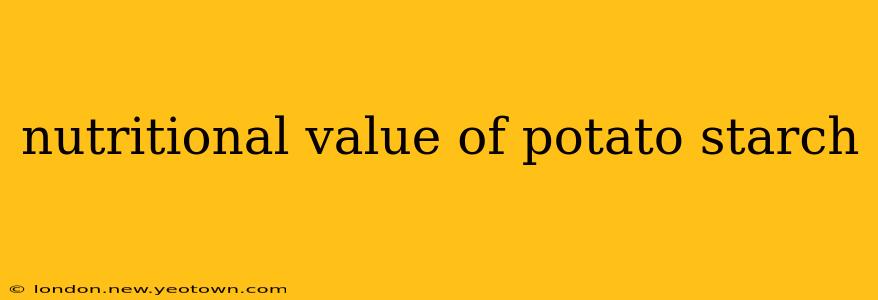Potato starch, a ubiquitous ingredient in countless food products, often gets overlooked in conversations about nutrition. While it might not be a nutritional powerhouse like broccoli or berries, understanding its nutritional value is crucial, especially for those with dietary restrictions or specific health goals. This isn't just about calories; it's about understanding the role this ingredient plays in our diets.
Let's embark on a journey to uncover the nutritional profile of potato starch and address some common questions surrounding its use.
What is the nutritional composition of potato starch?
Potato starch, as the name suggests, is derived from potatoes. The process involves washing, peeling, and grinding the potatoes to release the starch, which is then refined and dried. This leaves behind a primarily carbohydrate-based product. A typical 100-gram serving of potato starch boasts approximately 340 calories, almost entirely from carbohydrates. The protein and fat content is negligible. It contains virtually no vitamins or minerals in significant amounts.
This doesn't mean it's nutritionally void. Its role is primarily as a thickening agent, and its carbohydrate content can provide energy. However, it's not a primary source of essential nutrients.
Does potato starch contain any vitamins or minerals?
While potato starch itself is lacking in significant amounts of vitamins and minerals, it's important to remember that the nutritional profile of the original potato is quite different. Potatoes contain vitamin C, potassium, and some B vitamins. However, the starch extraction process removes most of these nutrients. Therefore, relying on potato starch as a source of vitamins and minerals would be unproductive.
Is potato starch gluten-free?
Yes, potato starch is naturally gluten-free, making it a suitable ingredient for individuals with celiac disease or gluten sensitivity. However, always check product labels to ensure that there's been no cross-contamination during processing.
What are the glycemic index (GI) and glycemic load (GL) of potato starch?
Potato starch boasts a relatively high glycemic index (GI), meaning it can cause a rapid rise in blood sugar levels. The exact GI value can vary based on factors like processing methods, but it generally sits in the high range. The glycemic load (GL) takes into account both the GI and the amount of carbohydrate consumed, so the GL will also be relatively high. Individuals with diabetes or those monitoring their blood sugar should consume potato starch in moderation and ideally as part of a balanced meal with other foods to help moderate the blood sugar response.
Is potato starch suitable for people with diabetes?
As previously mentioned, potato starch has a high GI, meaning it can cause a rapid spike in blood sugar levels. Therefore, individuals with diabetes should consume potato starch sparingly and in controlled portions, always integrating it into a balanced meal plan. It’s essential to consult a doctor or registered dietitian for personalized dietary advice, particularly if managing diabetes.
How is potato starch used in food?
Potato starch's primary function is as a thickening agent in various food products. You'll find it in sauces, gravies, soups, and baked goods, contributing to their texture and consistency. It also acts as a stabilizer and binder in some processed foods.
Conclusion: A Functional Ingredient, Not a Nutritional Superstar
Potato starch serves a vital role in the food industry, primarily as a thickening agent and stabilizer. However, it's not a significant source of vitamins, minerals, or other essential nutrients. While it provides carbohydrates for energy, its high glycemic index warrants mindful consumption, particularly for individuals managing diabetes or blood sugar levels. Understanding its nutritional profile allows for informed choices, ensuring it's used appropriately within a balanced and healthy dietary plan.

